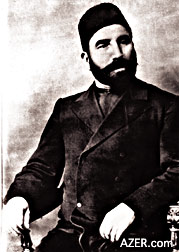|
Taghiyev's
residence, which takes up an entire city block, is truly palatial
in design and truly has the most complex artwork of any of the
buildings in the city. One must not forget that Taghiyev never
had the chance to go to school and could neither read nor write.
Historical Background In 1873, Taghiyev along with two partners [the Sarkis Brothers] rented a plot of land in Bibi-Heybat [one of the first places in the Baku region where oil was discovered]. They hired workers, bought the necessary equipment and started drilling for oil. Eventually, Taghiyev's partners gave up and sold their shares to Taghiyev. His persistence paid off and his efforts were rewarded with a gusher. Such is "the rags-to-riches" story line of how Zeynalabdin Taghiyev, son of a poor shoemaker, became a millionaire, one of Baku's most prominent Oil Barons. The Italian Renaissance-style mansion is immense and takes up an entire city block. There are four floors in some parts of the building. It was designed by Polish architect Joseph V. Goslavski, who later worked on Baku's City Hall and Taghiyev's boarding school for Azerbaijani girls, which today houses the Institute of Manuscripts. When the Red Army entered Baku in 1920, Taghiyev refused to leave the country though most other wealthy entrepreneurs fled immediately and established themselves in Europe. Others committed suicide or were exiled or killed. Taghiyev was in his late 90s at the time and decided not to leave the country, convinced that he had done so much for the country as a philanthropist that no one would dare harm him or his family. To this day, Taghiyev is esteemed as the most generous of the oil barons though he was not the wealthiest. When the Bolsheviks took over the city in 1920, Taghiyev's residence - like that of other wealthy oil barons - was immediately confiscated. Taghiyev was given permission to leave the city and to move to his summer home in Mardakan, a suburb of Baku, down by the sea on the Absheron Peninsula. Because Tahigyev's mansion was so elaborate, there seems to have been a real desire on the part of the Bolsheviks to preserve it as a showpiece. Under a resolution of the USSR People's Commissariat, the residence was established as a museum in June 1920, only a few months after the Bolsheviks took Baku. Architectural Features The exterior of Taghiyev's residence is not nearly as impressive as its interior. In fact, it's easy to ignore this building if you base your decision upon the façade alone. Don't do that. When the museum reopens, the Taghiyev Museum should be at the very top of everyone's list of places to visit in Baku. If you have a chance to see only one Oil Baron mansion in Baku, this should be the one. Be sure to visit the second floor. Side by side are two major ballrooms. One is based on Oriental designs (Mauritanian) style and the other, on Occidental design. The Oriental Room has enormous plate glass windows, gilded arches, highly ornamental walls, ceilings and chandeliers. The lines in the Occidental Room are more perpendicular to each other - rectangular. The majority
of spaces in the Taghiyev Museum have been closed off to the
public. In the past, these rooms, had very elaborate furnishings.
Today there is nothing except windows, doors, parquet floors
and ceilings. |




















